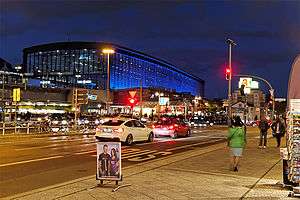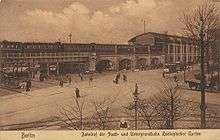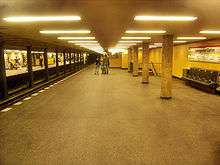Berlin Zoologischer Garten railway station
| Bf | |
 | |
| Location |
Hardenbergplatz 10623 Berlin Charlottenburg-Wilmersdorf, Berlin, Berlin Germany |
| Coordinates | 52°30′26″N 13°19′57″E / 52.50722°N 13.33250°ECoordinates: 52°30′26″N 13°19′57″E / 52.50722°N 13.33250°E |
| Line(s) | |
| Platforms | 6 |
| Other information | |
| Station code | 0533 |
| DS100 code | BZOO |
| Category | 2[1] |
| Website | www.bahnhof.de |
| History | |
| Opened | 7 February 1882 |
| Traffic | |
| Passengers | 100,000 per day[2] |
Berlin Zoologischer Garten Station (German: Bahnhof Berlin Zoologischer Garten, colloquially Bahnhof Zoo) is a railway station in Berlin, Germany. It is located on the Berlin Stadtbahn railway line in the Charlottenburg district, adjacent to the Berlin Zoo.
During the division of the city, the station was the central transport facility of West Berlin, and thereafter for the western central area of reunified Berlin until the opening of Berlin Hauptbahnhof in 2006. It is also an interchange with the U-Bahn and the S-Bahn, which uses the Stadtbahn viaduct along with RegionalExpress and RegionalBahn trains.
Overview
The station building overlooks the Hardenbergplatz square, named after Prussian prime minister Karl August von Hardenberg (1750–1822), Berlin's largest city bus terminal and night bus service centre. It is also used by long-distance buses/coaches, however the "ZOB", Berlin's central intercity bus terminal, is located on Messedamm in Westend, not far from the Funkturm.
Zoologischer Garten is also a Berlin U-Bahn station and S-Bahn station located at the Berlin Zoologischer Garten terminal, serving the U-Bahn lines U2 and U9, as well as by the S-Bahn lines S5, S7, and S75.
History

The original station served by Berlin Stadtbahn commuter trains opened on 7 February 1882. On 11 March 1902 the first Berlin U-Bahn line, today the U2, was opened under ground. With a view to the 1936 Summer Olympics, the station was rebuilt from 1934 to 1940, and the track installations were expanded. After the final closure of the Anhalter Bahnhof in 1952, Bahnhof Zoo remained the only long-distance train station within West Berlin, operated by the Deutsche Reichsbahn of East Germany. On 28 August 1961, two weeks after the erection of the Berlin Wall, the new U-Bahn Line 9 was opened below the U2, connecting the station with the transportation network in the north-south direction.[3]

The fact that with only two platforms and four tracks for long-distance trains the station was still the most important in West Berlin was another unnatural phenomenon of the divided city. After reunification, despite the outcry from nearby Kurfürstendamm retailers and local politicians, the station dramatically lost its importance following the launching of the new Berlin Hauptbahnhof on 28 May 2006, with long-distance services now passing through the station without stopping. An exception is the famous Sibirjak departing from Bahnhof Zoo for the Novosibirsk Trans-Siberian railway station. Periodically the EuroNight Paris-Berlin stops here.
Train services
The station is served by the following services:[4]
- Regional services IRE Hamburg – Uelzen – Stendal – Berlin
- Regional services RE 1 Magdeburg – Brandenburg – Potsdam – Berlin – Fürstenwalde – Frankfurt (Oder) (– Cottbus)
- Regional services RE 2 Wismar – Schwerin – Wittenberge – Nauen – Berlin – Königs Wusterhausen – Lübben – Cottbus
- Regional services RE 7 Dessau – Bad Belzig – Michendorf – Berlin – Berlin-Schönefeld Airport – Wünsdorf-Waldstadt
- Local services RB 14 Nauen – Falkensee – Berlin – Berlin-Schönefeld Airport
- Local services RB 21 Wustermark – Golm – Potsdam – Berlin
- Local services RB 22 Königs Wusterhausen – Berlin-Schönefeld Airport – Saarmund – Golm – Potsdam – Berlin
- Berlin S-Bahn services
 Spandau - Westkreuz - Hauptbahnhof - Alexanderplatz - Ostbahnhof - Lichtenberg - Strausberg Nord
Spandau - Westkreuz - Hauptbahnhof - Alexanderplatz - Ostbahnhof - Lichtenberg - Strausberg Nord - Berlin S-Bahn services
 Potsdam - Wannsee - Westkreuz - Hauptbahnhof - Alexanderplatz - Ostbahnhof - Lichtenberg - Ahrensfelde
Potsdam - Wannsee - Westkreuz - Hauptbahnhof - Alexanderplatz - Ostbahnhof - Lichtenberg - Ahrensfelde - Berlin S-Bahn services
 Spandau - Westkreuz - Hauptbahnhof - Alexanderplatz - Ostbahnhof - Lichtenberg - Wartenberg
Spandau - Westkreuz - Hauptbahnhof - Alexanderplatz - Ostbahnhof - Lichtenberg - Wartenberg
| Preceding station | Deutsche Bahn | Following station | ||
|---|---|---|---|---|
toward Hamburg Hbf | RE IRE | toward Berlin Ostbahnhof |
||
| RE 1 | ||||
toward Dessau Hbf | RE 7 | toward Wünsdorf-Waldstadt |
||
toward Nauen | RB 14 | toward Berlin Schönefeld Flughafen |
||
toward Wustermark | RB 21 | toward Berlin Friedrichstraße |
||
toward Königs Wusterhausen | RB 22 | toward Berlin Friedrichstraße |
||
| Preceding station | Ostdeutsche Eisenbahn | Following station | ||
toward Wismar | RE 2 | toward Cottbus |
||
| Preceding station | Berlin S-Bahn | Following station | ||
toward Spandau | S5 | toward Strausberg Nord |
||
toward Potsdam Hbf | S7 | toward Ahrensfelde |
||
toward Spandau | S75 | toward Wartenberg |
||
| Preceding station | Berlin U-Bahn | Following station | ||
towards Ruhleben | U2 | towards Pankow |
||
towards Rathaus Steglitz | U9 | towards Osloer Straße |
Zoo Station in popular culture

- The station is well known as the setting of the 1978 book Wir Kinder vom Bahnhof Zoo ("We children from Zoo Station"), written by the Stern journalists Kai Hermann and Horst Rieck according to the interviews with Christiane Felscherinow. It became a bestseller in Germany, dramatising the period in the late 1970s when the rear of the station facing Jebensstraße was a meeting point for rent-boys, teen runaways, and drug addicts. The film Christiane F. – We Children from Bahnhof Zoo directed by Uli Edel was released in 1981.
- The 1991 U2 song "Zoo Station" was inspired by the station, written while the band was recording Achtung Baby at the Hansa Tonstudio in Berlin, which in turn inspired their Zoo TV Tour and the album Zooropa. Although the U-Bahn line U2 today passes through the station, it was numbered U1 at the time; a rearrangement and renumbering of the line took place in November 1993, when the section linking it to the remainder of the line in former East Berlin was reopened.
- The song "Auf'm Bahnhof Zoo" by Nina Hagen released on the 1978 album Nina Hagen Band refers to the station.
- The song "Zootime" by Mystery Jets ends with the line Wir sind die Kinder vom Bahnhof Zoo.
- "Bahnhof Zoo" is also a track on the 2005 album Randy the Band by the Swedish band Randy.
- The song "Big in Japan" by Alphaville refers to the Zoo station in the line "Should I stay here at the Zoo".
- The song "Bahnhof Zoo" by port-royal takes its name from the station.
- The song "Slept" by The Sisters of Mercy was inspired by this station.
- The book "Zoo Station: Adventures in East and West Berlin" by Ian Walker was published in 1987 by the Atlantic Monthly Press. It recounts the author's experiences in 1980s Berlin, his encounters with the young people on both sides of the wall, and their separation and occasional commingling.
- The book "Zoo Station" by David Downing published by Soho Press in 2007. It is the first in a series of World War II spy thrillers set in Berlin.
- Zoo Bahnhof was one of the murder scenes in The Pale Criminal (1990), a historical detective novel by Philip Kerr.
References
4.)(Hardenberg-Platz)-(Berlin-Charlottenburg)(translation in English maybe:(hardenberg-place) or.(hardenberg-squer), 5.)(busstop-centeal-station from (berlin-bus-(lines)-(bvg).
- ↑ "Stationspreisliste 2016" [Station price list 2016] (PDF) (in German). DB Station&Service. 1 December 2015. Retrieved 24 January 2016.
- ↑ "Hauptbahnhof bewährt sich". Der Tagesspiegel (in German). 24 December 2006.
- ↑ J. Meyer-Kronthaler, Berlins U-Bahnhöfe, Berlin: be.bra, 1996
- ↑ Timetables for Berlin Zoologischer Garten station (German)
External links
-
 Media related to Berlin Zoologischer Garten railway station at Wikimedia Commons
Media related to Berlin Zoologischer Garten railway station at Wikimedia Commons